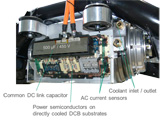Electric motor integrated power electronics with Smart Stator Teeth (SST)
Within the EMiLE project, ten partners from the German industry and research-institutes are working on innovative drivetrain solutions for tomorrow's e-mobility. The project focusses on compact and efficient electric vehicle traction-drives with a high degree of integration of electric machine, power electronics, and gearing, which are perspectively suitable for large scale production. High power density, high efficiency and cost minimization are benefits of the realized Smart Stator Tooth - structure within the drive unit. Each stator segment of the PMSM electric machine has its own individual control and power electronics. The modular system approach can be adapted to different vehicle and drive classes.
Drivetrain with Smart Stator Teeth
Each Smart Stator Tooth (SST) consists of a motor segment and an electronics assembly. Twelve SST form one PMSM stator and the corresponding inverter.
Each tooth electronic consists of an IGBT full bridge power-module, phase current sensor, current control loop, gate driver unit, and a fault detection block. The stator windings are directly connected to the AC terminals of the power module, thus minimizing space and reducing the number of parts. The pre-assembled SST is fully testable before mounting the complete system.
Novel Control and Safety Functions
The advanced SST control functionalities have two objectives: First, a failure in one phase power module does not lead to a full system failure. Second, after detecting faulty parts, the remaining SST are used to actively compensate the influence of the failure.
The SST concept redefines and improves both availability and failure mitigation: The aim is to achieve a safe system state, concerning vehicle stability and passenger safety, without additional hardware effort. At the same time, the availability is increased, which means that partial faults do not stop the whole system.
Project Partners: VDI|VDE|IT, Aix Control, Bosch, Infineon, iSEA RWTH Aachen, Lenze, Siemens, TDK-EPC, VW, ZF
Funding: German Federal Ministry for Education and Research
Download Product Sheet "EMiLE - Electric motor integrated power electronics"

 Fraunhofer Institute for Integrated Systems and Device Technology IISB
Fraunhofer Institute for Integrated Systems and Device Technology IISB


















